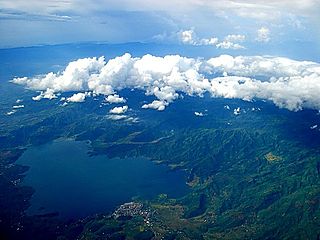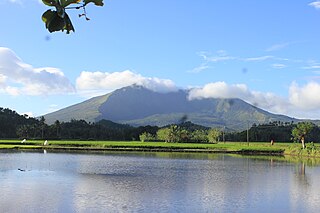
Aquaculture, also known as aquafarming, is the controlled cultivation ("farming") of aquatic organisms such as fish, crustaceans, mollusks, algae and other organisms of value such as aquatic plants. Aquaculture involves cultivating freshwater, brackish water and saltwater populations under controlled or semi-natural conditions, and can be contrasted with commercial fishing, which is the harvesting of wild fish. Mariculture, commonly known as marine farming, refers specifically to aquaculture practiced in seawater habitats and lagoons, opposed to in freshwater aquaculture. Pisciculture is a type of aquaculture that consists of the culturing of fish to obtain fish and fish products as food.

The Eurasian or European carp, formerly known as the common carp is a widespread freshwater fish of eutrophic waters in lakes and large rivers in Europe and Asia. The native wild populations are considered vulnerable to extinction by the International Union for Conservation of Nature (IUCN), but the species has also been domesticated and introduced into environments worldwide, and is often considered a destructive invasive species, being included in the list of the world's 100 worst invasive species. It gives its name to the carp family, Cyprinidae.

Tilapia is the common name for nearly a hundred species of cichlid fish from the coelotilapine, coptodonine, heterotilapine, oreochromine, pelmatolapiine, and tilapiine tribes, with the economically most important species placed in the Coptodonini and Oreochromini. Tilapia are mainly freshwater fish inhabiting shallow streams, ponds, rivers, and lakes, and less commonly found living in brackish water. Historically, they have been of major importance in artisanal fishing in Africa, and they are of increasing importance in aquaculture and aquaponics. Tilapia can become a problematic invasive species in new warm-water habitats such as Australia, whether deliberately or accidentally introduced, but generally not in temperate climates due to their inability to survive in cold water.

The milkfish is the sole living species in the family Chanidae. However, there are at least five extinct genera from the Cretaceous. The repeating scientific name (tautonym) is from Greek khanos.

Fishery can mean either the enterprise of raising or harvesting fish and other aquatic life; or more commonly, the site where such enterprise takes place. Commercial fisheries include wild fisheries and fish farms, both in freshwater bodies and the oceans. About 500 million people worldwide are economically dependent on fisheries. 171 million tonnes of fish were produced in 2016, but overfishing is an increasing problem — causing declines in some populations.

A conventional idea of a sustainable fishery is that it is one that is harvested at a sustainable rate, where the fish population does not decline over time because of fishing practices. Sustainability in fisheries combines theoretical disciplines, such as the population dynamics of fisheries, with practical strategies, such as avoiding overfishing through techniques such as individual fishing quotas, curtailing destructive and illegal fishing practices by lobbying for appropriate law and policy, setting up protected areas, restoring collapsed fisheries, incorporating all externalities involved in harvesting marine ecosystems into fishery economics, educating stakeholders and the wider public, and developing independent certification programs.

The longnose gar, also known as longnose garpike or billy gar, is a ray-finned fish in the family Lepisosteidae. The genus may have been present in North America for about 100 million years. References are made to gars being a primitive group of bony fish because they have retained some primitive features, such as a spiral valve intestine, but gars are a highly evolved group of fish, and not primitive in the sense of not being fully developed.

The grass carp is a large, herbivorous, freshwater fish species of the family Cyprinidae native to eastern Asia, with an original range from northern Vietnam to the Amur River on the Siberia-China border. This Asian carp is the only species of the genus Ctenopharyngodon.

Siberian taimen, also known as the common taimen, Siberian giant trout or Siberian salmon, is a species of salmon-like ray-finned fish from the genus Hucho in the family Salmonidae. These fish are found in rivers in Russia and adjacent regions, and are harvested throughout the year.

The Atlantic salmon is a species of ray-finned fish in the family Salmonidae. It is the 3rd largest of the Salmonidae, behind Siberian Taimen and Pacific Chinook Salmon, growing up to a meter in length. Atlantic salmon are found in the northern Atlantic Ocean and in rivers that flow into this ocean. Most populations of this fish species are anadromous, hatching in streams and rivers but moving out to sea as they grow where they mature, after which the adult fish seasonally move upstream again to spawn.

The yellow perch, commonly referred to as perch, striped perch, American perch,American river perch or preacher is a freshwater perciform fish native to much of North America. The yellow perch was described in 1814 by Samuel Latham Mitchill from New York. It is closely related, and morphologically similar to the European perch ; and is sometimes considered a subspecies of its European counterpart. Other common names for yellow perch include American perch, coontail, lake perch, raccoon perch, ring-tail perch, ringed perch, and striped perch. Another nickname for the perch is the Dodd fish.

Pink salmon or humpback salmon is a species of anadromous fish in the salmon family. It is the smallest and most abundant of the Pacific salmon. The scientific species name is based on the Russian common name for this species gorbúša (горбуша), which literally means humpie.

Buhi, officially the Municipality of Buhi, is a 1st class municipality in the province of Camarines Sur, Philippines. According to the 2020 census, it has a population of 81,306 people.

The rainbow smelt is a North American species of fish of the family Osmeridae. Walleye, trout, and other larger fish prey on these smelt. The rainbow smelt prefer juvenile ciscoes, zooplankton such as calanoid copepods, and other small organisms, but are aggressive and will eat almost any fish they find. They are anadromous spring spawners and prefer clean streams with light flow and light siltation. The rainbow smelt face several barriers. They are weak swimmers and struggle to navigate fish ladders preventing them from making it past dams to the headwater streams where they spawn. The rise in erosion and dams helped to decimate the smelt population in the 1980s. There are currently plans to try to reduce damming and to help control erosion.

The bigmouth buffalo is a fish native to North America, that is vulnerable and in decline. It is the largest North American species in the Catostomidae or "sucker" family, and is one of the longest-lived and latest-maturing freshwater fishes, capable of living beyond 110 years and reproducing infrequently. Even at a century old they show no age-related declines, but instead improvements, making this species a biological marvel. It is commonly called the gourdhead, marblehead, redmouth buffalo, buffalofish, bernard buffalo, roundhead, or brown buffalo. The bigmouth buffalo is not a carp, nor is any other fish in the sucker family. Although they share the same order, each belong to different suborders and are native to separate continents.

Lake Buhi is a lake found in Buhi, Camarines Sur in the Philippines. It has an area of 18 square kilometres and has an average depth of 8 metres (26 ft). The lake lies in the valley formed by two ancient volcanoes, Mount Iriga and Mount Malinao. It was created in 1641, when an earthquake caused a side of Mount Asog to collapse. The resulting landslide created a natural dam that blocked the flow of nearby streams. Another theory suggests that it was created by the eruption of Mt. Asog, which is now dormant.
Barbodes manguaoensis is a species of cyprinid fish endemic to Lake Manguao in Palawan, the Philippines. This species can reach a length of 14 centimetres (5.5 in) TL.

A wild fishery is a natural body of water with a sizeable free-ranging fish or other aquatic animal population that can be harvested for its commercial value. Wild fisheries can be marine (saltwater) or lacustrine/riverine (freshwater), and rely heavily on the carrying capacity of the local aquatic ecosystem.

Lake Bato is a freshwater lake and the 7th largest in the Philippines. It is located in the town of Bato, approximately 9 kilometres (5.6 mi) southwest of Iriga City, Camarines Sur Province, southeastern Luzon, Philippines. It has extensive marshes and swamp forests. The lake drains into a tributary of the Bicol River which enters the sea near Naga City. Average depth is 8 metres (26 ft), and the bottom is muddy clay. The pH value is 6.1, the average dissolved oxygen 10 p.p.m., and the total hardness (SBY) 2.4.

Overexploitation, also called overharvesting, refers to harvesting a renewable resource to the point of diminishing returns. Continued overexploitation can lead to the destruction of the resource. The term applies to natural resources such as: wild medicinal plants, grazing pastures, game animals, fish stocks, forests, and water aquifers.




















